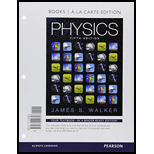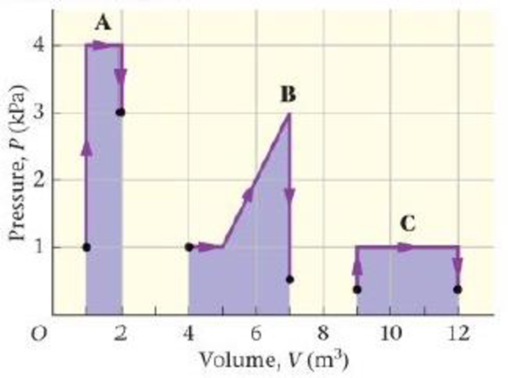
Physics, Books a la Carte Plus Mastering Physics with Pearson eText -- Access Card Package (5th Edition)
5th Edition
ISBN: 9780134032610
Author: James S. Walker
Publisher: PEARSON
expand_more
expand_more
format_list_bulleted
Textbook Question
Chapter 18, Problem 12PCE
Figure 18-26 shows three different multistep processes, labeled A, B, and C. Rank these processes in order of increasing work done by a gas that undergoes the process. Indicate ties where appropriate.
Figure 18-26 Problem 12

Expert Solution & Answer
Want to see the full answer?
Check out a sample textbook solution
Students have asked these similar questions
2
3
Imagine you are out for a stroll on a sunny day when you encounter a lake. Unpolarized light from the sun is reflected off the lake into your eyes. However, you notice when you put on your vertically polarized sunglasses, the light reflected off the lake no longer reaches your eyes. What is the angle between the unpolarized light and the surface of the water, in degrees, measured from the horizontal? You may assume the index of refraction of air is nair=1 and the index of refraction of water is nwater=1.33 . Round your answer to three significant figures. Just enter the number, nothing else.
Chapter 18 Solutions
Physics, Books a la Carte Plus Mastering Physics with Pearson eText -- Access Card Package (5th Edition)
Ch. 18.1 - System 1 is at 0 C and system 2 is at 0 F. If...Ch. 18.2 - Enhance Your Understanding (Answers given at the...Ch. 18.3 - Enhance Your Understanding (Answers given at the...Ch. 18.4 - Enhance Your Understanding (Answers given at the...Ch. 18.5 - Enhance Your Understanding (Answers given at the...Ch. 18.6 - Enhance Your Understanding (Answers given at the...Ch. 18.7 - Enhance Your Understanding (Answers given at the...Ch. 18.8 - Enhance Your Understanding (Answers given at the...Ch. 18.9 - Enhance Your Understanding (Answers given at the...Ch. 18.10 - Enhance Your Understanding (Answer given at the...
Ch. 18 - Prob. 1CQCh. 18 - Heat is added to a substance. Is it safe to...Ch. 18 - Are there thermodynamic processes in which all the...Ch. 18 - An ideal gas is held in an insulated container at...Ch. 18 - Prob. 5CQCh. 18 - Which law of thermodynamics would be violated if...Ch. 18 - Heat engines always give off a certain amount of...Ch. 18 - Prob. 8CQCh. 18 - Which law of thermodynamics is most pertinent to...Ch. 18 - Which has more entropy: (a) popcorn kernels, or...Ch. 18 - Prob. 1PCECh. 18 - A gas expands, doing 100 J of work. How much heat...Ch. 18 - A swimmer does 7.7 105 J of work and gives off...Ch. 18 - When 1310 J of heat are added to one mole of an...Ch. 18 - Three different processes act on a system. (a) In...Ch. 18 - A container holds a gas consisting of 2.85 moles...Ch. 18 - The Charge on Adhesive Tape When adhesive tape is...Ch. 18 - Predict/Calculate One mole of an ideal monatomic...Ch. 18 - Prob. 9PCECh. 18 - A cylinder contains 4.0 moles of a monatomic gas...Ch. 18 - An ideal gas is taken through the three processes...Ch. 18 - Figure 18-26 shows three different multistep...Ch. 18 - Prob. 13PCECh. 18 - An ideal gas is compressed at constant pressure to...Ch. 18 - As an ideal gas expands at constant pressure from...Ch. 18 - A system consisting of an ideal gas at the...Ch. 18 - Prob. 17PCECh. 18 - (a) Find the work done by a monatomic ideal gas as...Ch. 18 - Prob. 19PCECh. 18 - Predict/Calculate If 9.50 moles of a monatomic...Ch. 18 - Suppose 118 moles of a monatomic ideal gas undergo...Ch. 18 - A weather balloon contains an ideal gas and has a...Ch. 18 - Prob. 23PCECh. 18 - During an adiabatic process, the temperature of...Ch. 18 - An ideal gas follows the three-part process shown...Ch. 18 - With the pressure held constant at 260 kPa, 43 mol...Ch. 18 - Prob. 27PCECh. 18 - A system expands by 0.75 m3 at a constant pressure...Ch. 18 - Prob. 29PCECh. 18 - A certain amount of a monatomic ideal gas...Ch. 18 - An ideal gas doubles its volume in one of three...Ch. 18 - Predict/Explain You plan to add a certain amount...Ch. 18 - Find the amount of heat needed to increase the...Ch. 18 - (a) If 585 J of heat are added to 49 moles of a...Ch. 18 - A system consists of 3.5 mol of an ideal monatomic...Ch. 18 - Find the change in temperature if 170 J of heat...Ch. 18 - Gasoline Ignition Consider a short time span just...Ch. 18 - Prob. 38PCECh. 18 - Prob. 39PCECh. 18 - A monatomic ideal gas is held in a thermally...Ch. 18 - Consider the expansion of 60.0 moles of a...Ch. 18 - A Carnot engine can be operated with one of the...Ch. 18 - What is the efficiency of an engine that exhausts...Ch. 18 - An engine receives 660 J of heat from a hot...Ch. 18 - A Carnot engine operates between the temperatures...Ch. 18 - A nuclear power plant has a reactor that produces...Ch. 18 - At a coal-burning power plant a steam turbine is...Ch. 18 - Predict/Calculate A portable generator produces...Ch. 18 - Predict/Calculate The efficiency of a particular...Ch. 18 - During each cycle a reversible engine absorbs 3100...Ch. 18 - Prob. 51PCECh. 18 - The operating temperatures for a Carnot engine are...Ch. 18 - A certain Carnot engine takes in the heat Qh and...Ch. 18 - Predict/Explain (a) If the temperature in the...Ch. 18 - The refrigerator in your kitchen does 490 J of...Ch. 18 - A refrigerator with a coefficient of performance...Ch. 18 - Prob. 57PCECh. 18 - Prob. 58PCECh. 18 - An air conditioner is used to keep the interior of...Ch. 18 - A reversible refrigerator has a coefficient of...Ch. 18 - A freezer has a coefficient of performance equal...Ch. 18 - Predict/Explain (a) If you rub your hands...Ch. 18 - Predict/Explain (a) An ideal gas is expanded...Ch. 18 - Predict/Explain (a) A gas is expanded reversibly...Ch. 18 - Find the change in entropy when 1.85 kg of water...Ch. 18 - Determine the change in entropy that occurs when...Ch. 18 - Prob. 67PCECh. 18 - On a cold winters day heat leaks slowly out of a...Ch. 18 - An 88-kg parachutist descends through a vertical...Ch. 18 - Predict/Calculate Consider the air-conditioning...Ch. 18 - A heat engine operates between a high-temperature...Ch. 18 - It can be shown that as a mass m with specific...Ch. 18 - Prob. 73GPCh. 18 - Figure 18-34 Problem 74 74 CE An ideal gas has...Ch. 18 - The heat that goes into a particular Carnot engine...Ch. 18 - Predict/Calculate Consider 132 moles of a...Ch. 18 - Prob. 77GPCh. 18 - Prob. 78GPCh. 18 - Predict/Calculate Engine A has an efficiency of...Ch. 18 - Nuclear Versus Natural Gas Energy Because of...Ch. 18 - A freezer with a coefficient of performance of...Ch. 18 - Entropy and the Sun The surface of the Sun has a...Ch. 18 - Prob. 83GPCh. 18 - A cylinder with a movable piston holds 2.95 mol of...Ch. 18 - Making Ice You place 0.410 kg of cold water inside...Ch. 18 - An inventor claims a new cyclic engine that uses...Ch. 18 - Predict/Calculate A small dish containing 530 g of...Ch. 18 - Predict/Calculate An ideal gas is taken through...Ch. 18 - One mole of an ideal monatomic gas follows the...Ch. 18 - When a heat Q is added to a monatomic ideal gas at...Ch. 18 - The Carnot Cycle Figure 18-36 shows an example of...Ch. 18 - A Carnot engine and a Carnot refrigerator operate...Ch. 18 - Prob. 93PPCh. 18 - Energy from the Ocean Whenever two objects are at...Ch. 18 - Prob. 95PPCh. 18 - Energy from me Ocean Whenever two objects are at...Ch. 18 - Predict/Calculate Referring to Example 18-21...Ch. 18 - Predict/Calculate Referring to Example 18-21...
Additional Science Textbook Solutions
Find more solutions based on key concepts
Low-pressure centers are also referred to as ______, while high-pressure centers are called ______.
Applications and Investigations in Earth Science (9th Edition)
Plants use the process of photosynthesis to convert the energy in sunlight to chemical energy in the form of su...
Campbell Essential Biology with Physiology (5th Edition)
8. A human maintaining a vegan diet (containing no animal products) would be a:
a. producer
b. primary consume...
Human Biology: Concepts and Current Issues (8th Edition)
Describe an example of bioconversion. What metabolic processes can result in fuels?
Microbiology: An Introduction
1.3 Obtain a bottle of multivitamins and read the list of ingredients. What are four chemicals from the list?
Chemistry: An Introduction to General, Organic, and Biological Chemistry (13th Edition)
Which one of the following is not a fuel produced by microorganisms? a. algal oil b. ethanol c. hydrogen d. met...
Microbiology: An Introduction
Knowledge Booster
Learn more about
Need a deep-dive on the concept behind this application? Look no further. Learn more about this topic, physics and related others by exploring similar questions and additional content below.Similar questions
- 20. Two small conducting spheres are placed on top of insulating pads. The 3.7 × 10-10 C sphere is fixed whie the 3.0 × 107 C sphere, initially at rest, is free to move. The mass of each sphere is 0.09 kg. If the spheres are initially 0.10 m apart, how fast will the sphere be moving when they are 1.5 m apart?arrow_forwardpls help on allarrow_forwardpls help on thesearrow_forward
- pls help on all asked questions kindlyarrow_forwardpls help on all asked questions kindlyarrow_forward19. Mount Everest, Earth's highest mountain above sea level, has a peak of 8849 m above sea level. Assume that sea level defines the height of Earth's surface. (re = 6.38 × 106 m, ME = 5.98 × 1024 kg, G = 6.67 × 10 -11 Nm²/kg²) a. Calculate the strength of Earth's gravitational field at a point at the peak of Mount Everest. b. What is the ratio of the strength of Earth's gravitational field at a point 644416m below the surface of the Earth to a point at the top of Mount Everest? C. A tourist watching the sunrise on top of Mount Everest observes a satellite orbiting Earth at an altitude 3580 km above his position. Determine the speed of the satellite.arrow_forward
- pls help on allarrow_forwardpls help on allarrow_forward6. As the distance between two charges decreases, the magnitude of the electric potential energy of the two-charge system: a) Always increases b) Always decreases c) Increases if the charges have the same sign, decreases if they have the opposite signs d) Increases if the charges have the opposite sign, decreases if they have the same sign 7. To analyze the motion of an elastic collision between two charged particles we use conservation of & a) Energy, Velocity b) Momentum, Force c) Mass, Momentum d) Energy, Momentum e) Kinetic Energy, Potential Energyarrow_forward
arrow_back_ios
SEE MORE QUESTIONS
arrow_forward_ios
Recommended textbooks for you
 Physics for Scientists and Engineers: Foundations...PhysicsISBN:9781133939146Author:Katz, Debora M.Publisher:Cengage Learning
Physics for Scientists and Engineers: Foundations...PhysicsISBN:9781133939146Author:Katz, Debora M.Publisher:Cengage Learning Principles of Physics: A Calculus-Based TextPhysicsISBN:9781133104261Author:Raymond A. Serway, John W. JewettPublisher:Cengage Learning
Principles of Physics: A Calculus-Based TextPhysicsISBN:9781133104261Author:Raymond A. Serway, John W. JewettPublisher:Cengage Learning
 College PhysicsPhysicsISBN:9781305952300Author:Raymond A. Serway, Chris VuillePublisher:Cengage Learning
College PhysicsPhysicsISBN:9781305952300Author:Raymond A. Serway, Chris VuillePublisher:Cengage Learning College PhysicsPhysicsISBN:9781285737027Author:Raymond A. Serway, Chris VuillePublisher:Cengage Learning
College PhysicsPhysicsISBN:9781285737027Author:Raymond A. Serway, Chris VuillePublisher:Cengage Learning Physics for Scientists and EngineersPhysicsISBN:9781337553278Author:Raymond A. Serway, John W. JewettPublisher:Cengage Learning
Physics for Scientists and EngineersPhysicsISBN:9781337553278Author:Raymond A. Serway, John W. JewettPublisher:Cengage Learning

Physics for Scientists and Engineers: Foundations...
Physics
ISBN:9781133939146
Author:Katz, Debora M.
Publisher:Cengage Learning

Principles of Physics: A Calculus-Based Text
Physics
ISBN:9781133104261
Author:Raymond A. Serway, John W. Jewett
Publisher:Cengage Learning


College Physics
Physics
ISBN:9781305952300
Author:Raymond A. Serway, Chris Vuille
Publisher:Cengage Learning

College Physics
Physics
ISBN:9781285737027
Author:Raymond A. Serway, Chris Vuille
Publisher:Cengage Learning

Physics for Scientists and Engineers
Physics
ISBN:9781337553278
Author:Raymond A. Serway, John W. Jewett
Publisher:Cengage Learning
Thermodynamics: Crash Course Physics #23; Author: Crash Course;https://www.youtube.com/watch?v=4i1MUWJoI0U;License: Standard YouTube License, CC-BY